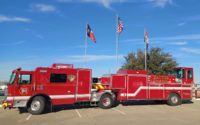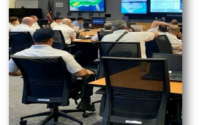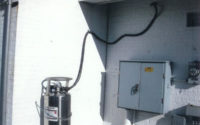Sammy Slime on the Salty Soapbox presents: Vitals Illusion Confusion – Part 2
Armando S. Bevelacqua
Welcome back. Last month we went back into the past and looked at some historical documents i.e. NFPA 471 and Don Abbotts HazMat Mayday project. This month, let’s look at this from the OSHA lens and explore this from a more systematic approach.
So, if a responder is going to wear SCBA, PAPR’s as part of their job duties that they must meet the respiratory standard (1910.134). Which has several components thereof. But basically, the worker will have to pass a physical, and fit test (I am not going to get into the details of this standard). So, for our discussion, the responder has had an annual or biannual physical (we will get there on this issue) to establish that he/she can perform the tasks required from a medical perspective, i.e., he/she can wear a respirator. Or stated differently are “fit for duty”!

Oh, you say that OSHA requires a pre-entry physical. First let’s go back to the 1980’s when NFPA 471 was developed, and the bases of medical documentation used a best practice AT THE TIME. We are going back to the day when there were NFPA documents to guide us, but the OSHA document that is quoted as CFR1910.120 had not been developed yet, it was still being written. And actually, some of the concepts from the original 471 was infused into what we now know as 1910.120. However, the developer of the OSHA document, used language that was a little less restrictive and more general. So, while we are here let’s dive into the OSHA document a bit, because what usually happens when this issue is brought up is the response of “well it’s in OSHA”. Which then stops the argument because truthfully how many of you have read 1910.120 in its entirety. Come on I am waiting!…….How many have actually read 1910.120? To be honest, it was several years of my career that I actually sat down and read the document. And it wasn’t until I co-authored the first Hazmat Medic book that I actually read the OSHA and the NFPA documents several times in their entirety so that I could speak about it within the Hazmat medic document.
In OSHA 1910.120 we see that medical examinations and consultations are given and a general guideline for these physicals are annual or biannual physicals unless the physician in charge believes that a longer interval is appropriate {1910.120 (f)(3)}. In the following paragraph {1910.120 (f)(3)(I)(D)} we see identification of medicals when a potential exposure has occurred. In other words, when signs and symptoms are presented. But no where do we see a pre-entry criteria. However, what we do see is reference towards a medical surveillance program which should be instituted by the employer. The annual or biannual physical would be part of that medical surveillance program, as well as the entry and post entry physicals. It’s the medical surveillance program that outlines what we do, not OSHA.
In chapter 10 of NFPA 471 we see pre-entry medical monitoring with chapter 10.3 establishing exclusion criteria which was in all editions through and including the 2002 edition. It was soon after this edition of 471 that it was abolished. Although this was the mainstream thought process in the 80’s through the 90’s, by the time of 2000 we see accepted practice for strenuous activity changing. What was accepted practice in previous years turned out to be different as time moved forward, we learned. Medical science was changing, and so were the concepts of best practice and recommended procedures. Rather functional assessments started to take hold. Meaning that annual physicals, before shift evaluations, proper hydration during the workday and exposure analysis became the focus. In other words, it is up to the authority having jurisdiction medical professionals to establish what and how this should be done, the medical surveillance program. I will say this, that baseline medicals should be done and are prudent to be done, but they are baselines and should be captured for just that a baseline. Take blood pressure as one example, moves up and down during the course of a day. There are patterns. For blood pressure a few hours before we wake, our pressures are high and increase peaking around lunch time. During the afternoon and evening the blood pressure starts to decrease (for you responders that are fighting BP problems make that doctors appointment in the afternoon!).
So, let’s revisit the main question of how we give medical crews guidance towards the health and safety of the hazmat team, the entry team specifically. What is the ability of an individual to go into a hot zone? Listen we have to realize a simple fact that when we place a responder into a fully encapsulating suit that we are basically placing that person in a hazardous environment to walk in an even higher level of concern. Yes, the interior of that suit is a hazard and should be considered a hazard! It is a hazard from a heat stress perspective. So yes, I am placing you in a layer of protection that can cause harm in order to place you in an environment that will cause even more harm! Then I ask you to do strenuous activity within the suit within the environment, an added layer of stress.
The real question becomes can I truly evaluate you before I place you in that environment? Do I evaluate you before you enter the fire building, how about that complex pin job in the middle of the summer (or winter for that matter)? But I do want to medically evaluate you before a hazmat call?! I am not saying here that evaluating our personnel before the entry is a bad idea, I just think we need to re-evaluate the process, and by doing so we can evaluate the potential outcomes.

I have presented this issue as to poke fun at a complex yet needed evaluation of a procedure that is blindly done without thought. It is currently done as an objective to meet and a box to check off in the beginning stages of a hazmat event. Am I a proponent of pre-entry physicals, yes but depending on the circumstances. Let me get in to the weeds a bit more. To give a complete picture of a medical evaluation Blood Pressure, Pulse (Heart Rate and EKG), and respirations (SaO2) are the factors we can look at in the field. We also have capnography which along with SaO2 can establish how well (or not so well) we are metabolizing. But this only gives us the moment in time from which we have to make a decision. Can this person go or not? We could take these “vital signs” in the morning at the beginning of shift or before shift just to get a baseline. But are we truly doing this to make us feel comfortable? Is it necessary? We have stated earlier that during evaluations of some documented maydays that vitals were such that the individual that got hurt was evaluated as having a problem before they went into the hazard area. Would vitals check in the morning at the beginning of shift pick up on that? Would the medic in charge pick up on that?
Having a list of objectives from a medical perspective is a good thing but should not have exclusionary clauses for them. Determination of allowing an entry team member to make entry into the hot zone MUST be done by an educated medic. The entry criteria must be flexible based on each entry member, the incident, and the activity. It should serve as guidance to the team not a hindrance. Lastly are pre-entry physicals required by OSHA…… if you find it in 1910.120 let me know because I have not seen it!
If you hoped to have a black and white answer here let me start with this. Something I brought up last month; Complex problems are truly managed by understanding the basic concepts – be a critical thinker. With that said here is my formula for pre-entry physicals:
- Take the entry physicals in the morning at the beginning of shift. Yea the numbers may be jacked up because it is the morning (Remember what I said earlier about BP), but we are just getting a baseline. These are just to evaluate in comparison to post entry physicals.
- Look at your incident if this is going to be a protracted event, then yes pre-entry at the time of event is warranted. If this is a bread-and-butter case skip it, remember we all have an annual physical and have to meet the respiratory standard we should be fit for duty.
- No matter what there is NO exclusion criteria, this is managed on a case-by-case basis depending on what the educated and experienced medic evaluates. You don’t have a hazmat medic ok, then train one or two they are your medical team. Wouldn’t you want them to understand the complete picture in the event you the responder has a problem?
- Use the EMS tools effectively, just don’t take numbers to write them down to wash your hands of that task. This is a thinking man’s game, and if you are going to evaluate your team, the medic in charge should be trained to the highest level as well. Invest in your people.
Remember complex problems are truly managed by understanding the basic concepts.




